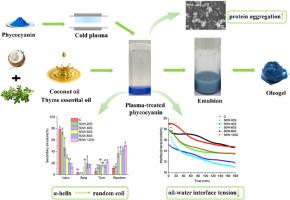Effect of cold plasma treatment on the structure and emulsifying activities of phycocyanin
IF 5.3
2区 农林科学
Q1 ENGINEERING, CHEMICAL
引用次数: 0
Abstract
Modifying natural active proteins through non-thermal processing techniques to obtain their functional diversity is an interesting and challenging aspect in the food industry. In this study, cold plasma was employed as a sustainable and efficient processing technique for phycocyanin (PC) modification. The cold plasma treatment improved the foaming property of PC. Moreover, subjecting PC to cold plasma treatment at 50 W for 20–60 s significantly reduced the oil-water interfacial tension. Conversely, plasma treatment reduced the elasticity of the PC interfacial layer and diminished the interactions between the proteins in that layer. Simultaneously, the particle size of PC increased while its secondary structure transitioned from alpha-helix to random coil after cold plasma treatment. SEM analysis revealed an augmented aggregation tendency among PC with extended cold plasma treatment duration. Additionally, a plasma-modified PC (50 W, 20 s) was utilized to develop an emulsion incorporating thyme essential oil and coconut oil, which displayed a more compact and porous microstructure and demonstrated antimicrobial activity against E. coli. This study proposes a simple and effective method for PC modification, and demonstrates that the functional properties of PC can be effectively enhanced by utilizing cold plasma technology at the appropriate processing time, thus providing a foundation for the application of PC and cold plasma technology in the field of food.

冷等离子处理对植物花青素结构和乳化活性的影响
在食品工业中,通过非热加工技术对天然活性蛋白质进行改性以获得其功能多样性是一个既有趣又具有挑战性的方面。在这项研究中,冷等离子体作为一种可持续的高效加工技术被用于植物花青素(PC)的改性。冷等离子处理改善了 PC 的发泡特性。此外,将 PC 放在 50 瓦的冷等离子体中处理 20-60 秒,可显著降低油水界面张力。相反,等离子处理降低了 PC 界面层的弹性,并减弱了该层中蛋白质之间的相互作用。同时,经冷等离子处理后,PC 的粒径增大,二级结构从α-螺旋转变为无规线圈。扫描电子显微镜分析表明,随着冷等离子处理时间的延长,PC 的聚集趋势增强。此外,还利用等离子体改性 PC(50 瓦,20 秒)开发了一种含有百里香精油和椰子油的乳液,其微观结构更加紧凑多孔,对大肠杆菌具有抗菌活性。本研究提出了一种简单有效的 PC 改性方法,并证明了在适当的加工时间内利用冷等离子体技术可有效提高 PC 的功能特性,从而为 PC 和冷等离子体技术在食品领域的应用奠定了基础。
本文章由计算机程序翻译,如有差异,请以英文原文为准。
求助全文
约1分钟内获得全文
求助全文
来源期刊

Journal of Food Engineering
工程技术-工程:化工
CiteScore
11.80
自引率
5.50%
发文量
275
审稿时长
24 days
期刊介绍:
The journal publishes original research and review papers on any subject at the interface between food and engineering, particularly those of relevance to industry, including:
Engineering properties of foods, food physics and physical chemistry; processing, measurement, control, packaging, storage and distribution; engineering aspects of the design and production of novel foods and of food service and catering; design and operation of food processes, plant and equipment; economics of food engineering, including the economics of alternative processes.
Accounts of food engineering achievements are of particular value.
 求助内容:
求助内容: 应助结果提醒方式:
应助结果提醒方式:


